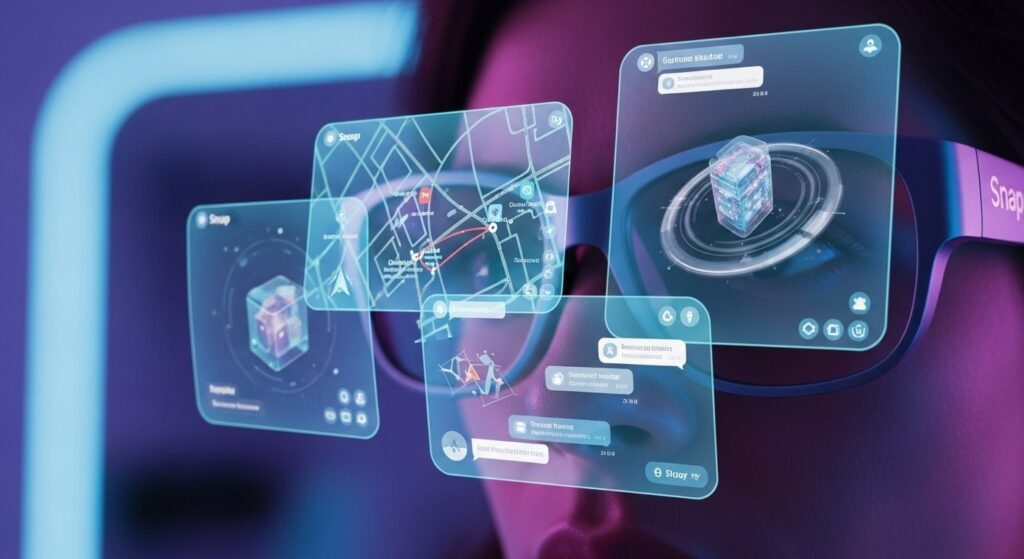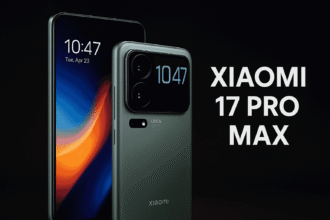Snap Inc. has announced that it will release its first consumer AR glasses, called Specs, in 2026. Describing years of R&D and a $3 billion investment, Snap CEO Evan Spiegel calls Specs “an ultra-powerful wearable computer” built into a lightweight pair of glasses with see-through lenses that “enhance the physical world with digital experiences. In practice, Specs will overlay computer-generated graphics onto what you see. As Meta recently explained for its own AR research, such devices use the physical world as a canvas for holographic content, powered by contextual AI, while remaining lightweight enough to wear comfortably.
Designed to bring AI and immersive content into your vision, Snap’s Specs will interpret the environment with onboard cameras and machine learning. The company says Specs will “understand the world around you” and insert virtual objects accordingly. They will support hands-free web browsing and video streaming (“a flexible … workstation”), as well as social AR gaming with friends. Crucially, Specs will run independently (unlike earlier smartglasses tethered to a phone); they contain dual processors and four cameras for real-time spatial computing. According to Snap, Specs include a built-in AI assistant and will support voice and gesture control. Under the hood, Snap OS 2.0—a new AR-focused operating system—will power the glasses natively (no phone needed) and even include a web browser for WebXR content.
Features and Technical Specs
Specs will feature a see-through LCoS display with roughly a 46° diagonal field of view. Snap says that feels like looking at a 100-inch screen from 10 feet away. The lenses automatically tint in bright sunlight for clarity, while waveguide optics keep the design slim. Two Qualcomm Snapdragon chips handle performance and efficiency. Battery life is currently expected to be about 45 minutes of continuous use, meaning the glasses are meant for shorter, frequent sessions rather than all-day wear.
The consumer model will cut down the weight from Snap’s previous developer kit and arrive in a classic black style. Advanced AI and tracking will be built in, with four cameras feeding into Snap’s spatial engine for precise tracking and real-time understanding of surroundings. New APIs allow developers to anchor AR objects, perform speech-to-text in over 40 languages, and even generate 3D objects on demand. Specs integrate with OpenAI and Google Gemini models, enabling translations, recipe suggestions, and contextual information directly in your view. Camera access is routed through a secure gateway to protect privacy.
Key Specs (expected):
- Display: See-through holographic display (LCoS), ~46° diagonal FOV
- Compute: Dual Snapdragon processors, 4 cameras with hand and eye tracking, ~45 minutes battery life
- Connectivity: Wi-Fi and Bluetooth, untethered operation
- AI & Sensors: On-device machine learning plus cloud AI, voice control, gesture recognition, and depth sensing
Use Cases and Developer Ecosystem

Snap is counting on its AR developer community to drive adoption. Demonstrated use cases include real-time translation of menus and signs, augmented cooking guides, gaming overlays like virtual drum tutorials or pool shot assistance, and whimsical AR adventures. These highlight how Specs can mix education, utility, and entertainment.
For developers, Lens Studio now supports SnapOS 2.0, WebXR, and multimodal AI models. Developers can integrate their own machine learning tools and deploy content directly to Specs. For businesses, Snap has introduced fleet management tools and guided navigation for AR tours at events, museums, and retail venues. Early pilots with partners in entertainment and immersive experiences hint at a hybrid consumer and enterprise strategy.
On the business side, Snap envisions an ecosystem similar to an app store, where premium lenses and AR apps provide new revenue streams. Spiegel has emphasized that Specs are designed for context-aware information delivery rather than porting phone apps into glasses. Snap’s large base of AR Lens users, which already numbers in the billions of interactions daily, gives it a strong foundation.
Competing AR Glasses in 2026
Specs will enter a competitive landscape. Meta has already released Ray-Ban Smart Glasses with audio, cameras, and assistant features. In late 2025, Meta added Ray-Ban Display glasses with a heads-up display and gesture control. These retail at around $799 and support AI-powered translations and messaging. Meta is also developing more advanced AR prototypes like Project Orion, though these remain in testing.
Apple is pursuing its own path. The Vision Pro mixed reality headset debuted in 2023 at a premium price but had modest adoption due to cost. Apple Glass is expected around 2026 or 2027, likely starting as a smartglasses product with video recording and Siri integration before evolving into true AR displays in later versions.
Google continues its experiments with AR. After the failure of consumer Google Glass, the company has shifted toward enterprise and prototypes. Recent demonstrations showed Gemini-powered AR glasses that can identify landmarks and provide contextual information on the fly. Google is expected to expand in this space as AR hardware matures.
AR Market Trends and Outlook
The global AR and VR headset market is growing again, with shipments rising year over year. Meta leads in volume, while smaller players like XREAL are gaining traction with affordable smartglasses. Apple’s Vision Pro highlighted premium AR experiences, but its high cost kept it from dominating sales.

Consumer adoption remains a challenge. Many people are wary of bulky designs, limited battery life, or unclear use cases. Analysts believe that real utility, style, and price will determine success. AI integration is quickly becoming a must-have feature, as seen in Snap’s Specs, Meta’s Ray-Bans, and Google’s prototypes. Beyond consumers, enterprise adoption is strong, with AR used in manufacturing, healthcare, and education. Snap’s tools for events and retail experiences show it also has its eye on that market.
In summary, Snap’s Specs mark an important milestone. The company is betting on its decade of AR experience, its huge developer community, and new AI-powered tools to capture the next wave of computing. Whether Snap can outpace larger competitors remains uncertain, but the timing is right. Lighter, smarter, AI-driven AR glasses are finally arriving, and 2026 could be the year when wearable augmented reality takes a real step toward mainstream adoption.












